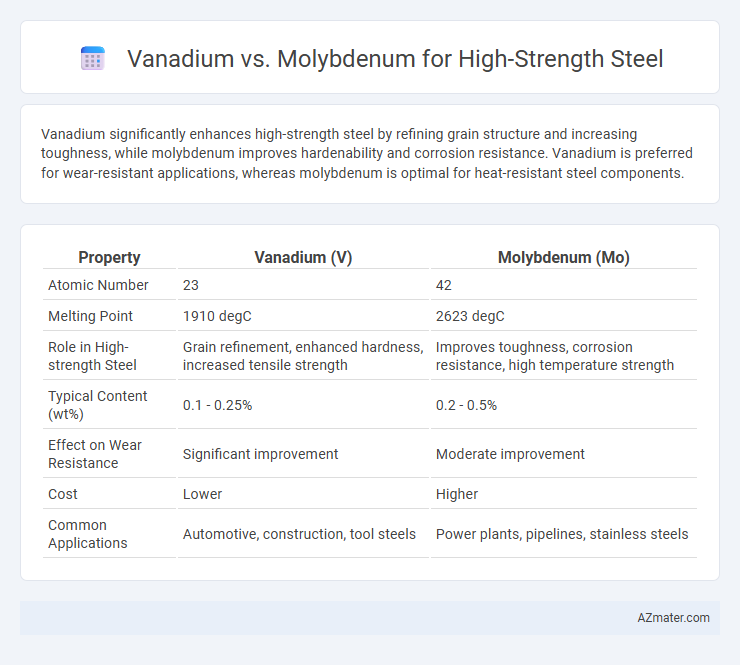Vanadium significantly enhances high-strength steel by refining grain structure and increasing toughness, while molybdenum improves hardenability and corrosion resistance. Vanadium is preferred for wear-resistant applications, whereas molybdenum is optimal for heat-resistant steel components.
Table of Comparison
| Property | Vanadium (V) | Molybdenum (Mo) |
|---|---|---|
| Atomic Number | 23 | 42 |
| Melting Point | 1910 degC | 2623 degC |
| Role in High-strength Steel | Grain refinement, enhanced hardness, increased tensile strength | Improves toughness, corrosion resistance, high temperature strength |
| Typical Content (wt%) | 0.1 - 0.25% | 0.2 - 0.5% |
| Effect on Wear Resistance | Significant improvement | Moderate improvement |
| Cost | Lower | Higher |
| Common Applications | Automotive, construction, tool steels | Power plants, pipelines, stainless steels |
Introduction: The Role of Alloying Elements in High-Strength Steel
Vanadium and molybdenum are critical alloying elements in high-strength steel, influencing microstructure and mechanical properties. Vanadium enhances grain refinement and precipitation hardening, leading to increased toughness and strength. Molybdenum improves hardenability and corrosion resistance, contributing to superior performance in demanding environments.
Vanadium in High-strength Steel: Properties and Benefits
Vanadium significantly enhances high-strength steel by refining grain size and promoting precipitation hardening, which increases strength and toughness without sacrificing ductility. Its ability to form stable carbides and nitrides improves wear resistance and fatigue performance, making vanadium-alloyed steels ideal for automotive and structural applications. Compared to molybdenum, vanadium provides superior hardness and strength at lower alloying levels, optimizing cost-effectiveness in high-strength steel production.
Molybdenum in High-strength Steel: Properties and Benefits
Molybdenum significantly enhances the strength, hardness, and corrosion resistance of high-strength steel by improving its microstructure and stabilizing carbides at elevated temperatures. Its ability to increase creep resistance and toughness makes molybdenum an essential alloying element for applications requiring durability in extreme environments. Compared to vanadium, molybdenum provides superior heat resistance and facilitates weldability, which extends the lifespan and reliability of steel components in critical industrial uses.
Physical and Mechanical Comparisons: Vanadium vs Molybdenum
Vanadium enhances high-strength steel by refining grain size and promoting precipitation hardening, leading to increased tensile strength and improved fatigue resistance, while maintaining good toughness. Molybdenum contributes to high-temperature strength and creep resistance, improving hardness and corrosion resistance without significantly affecting toughness. Physically, vanadium has a lower density (6.11 g/cm3) compared to molybdenum (10.28 g/cm3), influencing weight considerations in steel alloy design.
Impact on Steel Microstructure and Grain Refinement
Vanadium enhances high-strength steel by forming fine vanadium carbides and nitrides, which precipitate during cooling, leading to significant grain refinement and improved toughness. Molybdenum contributes to the microstructure by delaying recrystallization and promoting the formation of stable carbides, resulting in increased hardenability and strength. The combined effects of vanadium and molybdenum optimize grain size and precipitate distribution, crucial for achieving superior mechanical properties in advanced steel grades.
Influence on Strength, Toughness, and Hardenability
Vanadium significantly enhances high-strength steel by refining grain size, which boosts toughness and increases yield strength through the formation of fine vanadium carbides. Molybdenum primarily improves hardenability and corrosion resistance, allowing deeper hardening and retention of strength at elevated temperatures. The combination of vanadium and molybdenum in steel alloys creates a synergistic effect that optimizes strength, toughness, and hardenability for critical structural applications.
Corrosion Resistance: Evaluating Vanadium and Molybdenum
Vanadium enhances corrosion resistance in high-strength steel by promoting fine grain structures and forming stable carbides that inhibit crack propagation. Molybdenum significantly improves corrosion resistance in aggressive environments such as chloride-containing atmospheres by enhancing pitting and crevice corrosion resistance. The combined use of vanadium and molybdenum can synergistically increase the durability of high-strength steel against various corrosion mechanisms.
Cost Efficiency and Availability in Industrial Applications
Vanadium improves high-strength steel by enhancing hardness and wear resistance but tends to be more expensive and less abundant than molybdenum, affecting cost efficiency in large-scale industrial applications. Molybdenum offers good corrosion resistance and high-temperature strength at a generally lower cost and wider availability, making it a preferred alloying element for cost-sensitive projects. Industrial steel manufacturers often balance the superior strengthening properties of vanadium with the economic advantages of molybdenum to optimize performance and budget constraints.
Environmental and Processing Considerations
Vanadium offers superior environmental benefits in high-strength steel production due to its lower alloying addition requirements, resulting in reduced energy consumption and carbon emissions during processing. Molybdenum, while enhancing corrosion resistance and high-temperature strength, generally demands higher processing temperatures and longer heat treatment times, increasing energy use and environmental impact. Selecting vanadium optimizes steel production by minimizing ecological footprint and processing costs while maintaining excellent mechanical properties.
Conclusion: Selecting the Optimal Alloying Element for High-strength Steel
Vanadium enhances high-strength steel by promoting fine grain size and strong precipitation strengthening through vanadium carbides and nitrides, leading to improved toughness and weldability. Molybdenum contributes to hardness and creep resistance by forming stable carbides and improves corrosion resistance at elevated temperatures. For applications requiring superior toughness and weldability, vanadium is optimal, whereas molybdenum is preferable for high-temperature strength and corrosion resistance.

Infographic: Vanadium vs Molybdenum for High-strength Steel
 azmater.com
azmater.com